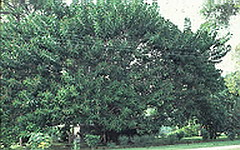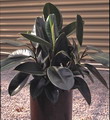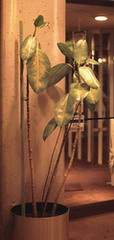|
A Low Light Story
|

A 30m House Plant! The common rubber tree, Ficus elastica, is a wonderful example. It’s called the rubber tree because it was tapped for its sap, which has a high latex component. The collected sap is used in the commercial production of
the truck tires that bring these plants from the nurseries in Florida to our homes. It is a native of SE. Asia and it grows into a very large tree when given the space and the light. This one is about 100 ft / 30 m, in width, growing in S Florida.
 Why Do We Try? Because we are attracted to its large shiny leaves we try to grow it in a small pot as a house plant. Typically we would find a plant like this one. It’s a 10 in / 25 cm pot that has one or more juvenile plants bearing a few leaves each. They are little more than rooted cuttings and yet given the correct conditions they can actually become a reasonable houseplant. Those conditions, if you think about the mature tree, should consist of a relatively high light level and enough soil moisture to keep it growing.
Why Do We Try? Because we are attracted to its large shiny leaves we try to grow it in a small pot as a house plant. Typically we would find a plant like this one. It’s a 10 in / 25 cm pot that has one or more juvenile plants bearing a few leaves each. They are little more than rooted cuttings and yet given the correct conditions they can actually become a reasonable houseplant. Those conditions, if you think about the mature tree, should consist of a relatively high light level and enough soil moisture to keep it growing.

Losing 3 of 8! When your houseplant has only a few, rather large, leaves then the loss of one or two of them can be quite significant. Attempts to grow these rubber trees in low light can produce the rather sickly specimen seen here. It has lost most of its leaves and the few remaining are getting progressively smaller and are always a sickly mottled yellow colour. The lack of light should be the obvious problem but I have seen people provide such plants with extra water and some fertilizer in a misguided attempt to stop the yellowing. At this point the best use of this plant is to supplement your compost pile.
return from Rubber Tree to Light is Essential
return from Low Light Rubber Tree to Houseplants main page
